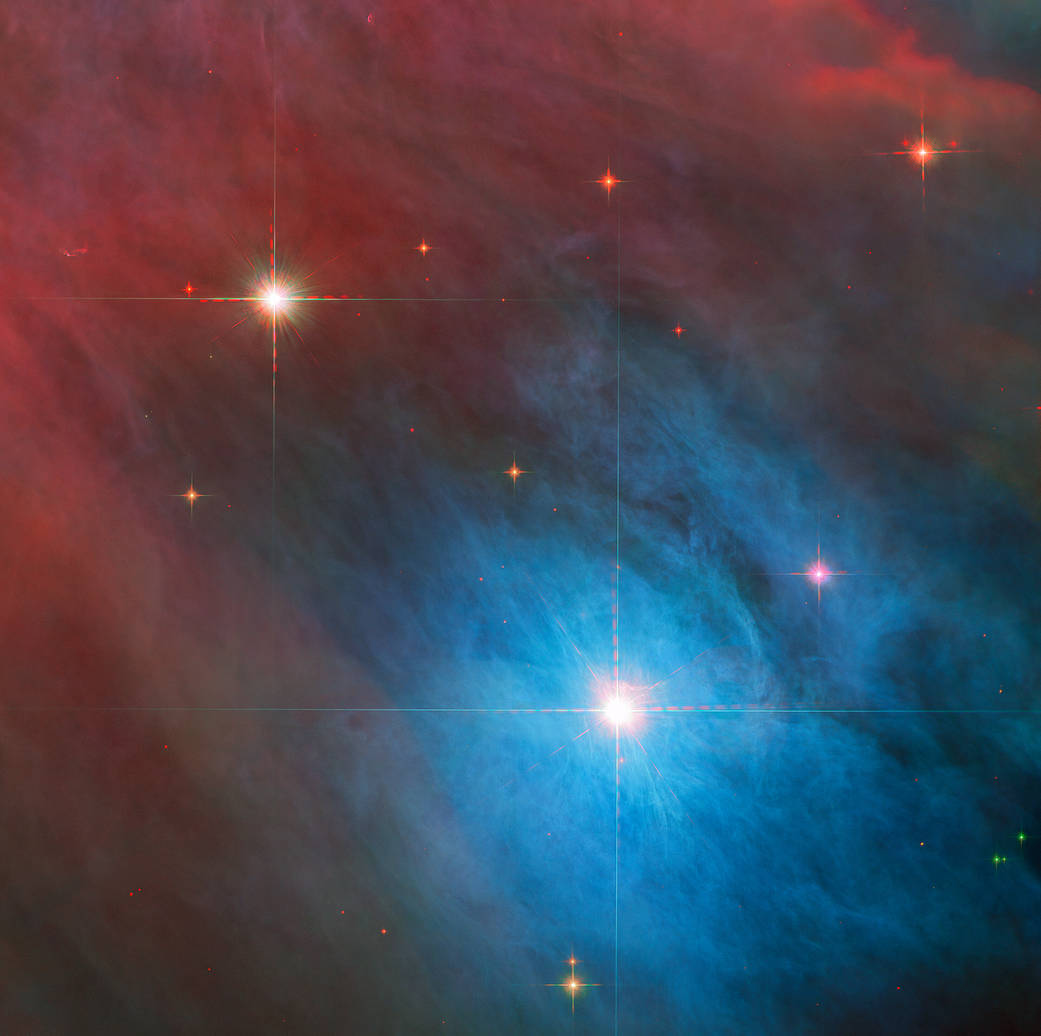The bright variable star V 372 Orionis takes center stage in this image from the NASA/ESA Hubble Space Telescope, which has also captured a smaller companion star in the upper left of this image. Both stars lie in the Orion Nebula, a colossal region of star formation roughly 1,450 light-years from Earth.
V 372 Orionis is a particular type of variable star known as an Orion Variable. These young stars experience some tempestuous moods and growing pains, which are visible to astronomers as irregular variations in luminosity. Orion Variables are often associated with diffuse nebulae, and V 372 Orionis is no exception; the patchy gas and dust of the Orion Nebula pervade this scene.
This image overlays data from two of Hubble’s instruments. Data from the Advanced Camera for Surveys and Wide Field Camera 3 at infrared and visible wavelengths were layered to reveal rich details of this corner of the Orion Nebula. Hubble also left its own subtle signature on this astronomical portrait in the form of diffraction spikes that surround the bright stars. The four spikes around the brightest stars in this image form when an intense point source of light, such as starlight, interacts with the four vanes inside Hubble that support the telescope’s secondary mirror. The diffraction spikes of the NASA/ESA/CSA James Webb Space Telescope, on the other hand, are six-pointed due to Webb’s hexagonal mirror segments and 3-legged support structure for the secondary mirror.
Text credit: European Space Agency (ESA)
Image credit: ESA/Hubble & NASA, J. Bally, M. Robberto
明亮的猎户座变星V 372在这张由NASA/ESA哈勃太空望远镜拍摄的图像中占据了中心位置,该望远镜还在这张照片的左上方观测到了一颗较小的伴星。这两颗恒星都位于猎户座星云中,猎户座星云是一个巨大的恒星形成区域,距离地球大约1450光年。
猎户座V 372是一种特殊类型的变星,被称为猎户座变星。这些年轻的恒星经历了一些暴风雨般的情绪和成长的痛苦,对天文学家来说,这是亮度的不规则变化。猎户座变星经常与弥散星云联系在一起,猎户座V 372也不例外;猎户座星云的气体和尘埃遍布在这幅画面中。
这张照片覆盖了哈勃望远镜的两个仪器的数据。来自高级巡天相机和宽视场相机3的红外和可见光波长的数据被分层,以揭示猎户座星云这个角落的丰富细节。哈勃还在这幅天文肖像上留下了自己微妙的特征,即围绕着明亮恒星的衍射尖峰。在这张图片中,围绕着最亮恒星的四个尖峰是由明亮的点光源(如星光)与哈勃望远镜内支撑望远镜副镜的四个叶片相互作用形成。而NASA/ESA/CSA詹姆斯·韦伯太空望远镜的衍射尖峰为六边形,这是由于韦伯的六角形镜段和副镜的三腿支撑结构。
文字来源:European Space Agency (ESA)
影像来源:ESA/Hubble & NASA, J. Bally, M. Robberto



